Free download: Top 10 Natural & Easy Remedies for Joint Pain from Home. Learn these helpful remedies.
Estimated Reading Time: 9 minutes read
Dealing with spinal nerve compression can be a challenging and painful experience. The condition, often marked by a sharp or burning pain, can significantly impact daily life. However, understanding the causes, symptoms, and effective exercises can help manage and alleviate this pain. This article offers straightforward and easy-to-follow advice on how to address spinal nerve compression through various exercises and care tips.
Spinal nerve compression, also known as pinched nerve, occurs when too much pressure is applied to a nerve by surrounding tissues, such as bones, cartilage, muscles, or tendons. This pressure disrupts the nerve’s function, leading to pain, tingling, numbness, or weakness. While this condition can occur in various parts of the body, the spine is a common site for nerve compression due to its complex structure and the weight it bears.
Table of Contents
Causes and Symptoms of Spinal Nerve Compression
Before diving into the exercises, it’s crucial to understand what might be leading to spinal nerve compression and how it manifests in the body. Here are some common causes and symptoms:
Causes of Spinal Nerve Compression
- Poor Posture: Sitting or standing in an incorrect posture for extended periods can lead to spinal misalignment and nerve compression.
- Injury: Accidents or trauma can cause immediate compression of the nerves in the spine.
- Repetitive Activities: Engaging in repetitive motions can strain the spine and surrounding tissues, leading to compression.
- Aging: Natural wear and tear over time can result in spinal degeneration and nerve compression.
- Obesity: Excess body weight can put additional stress on the spine and nerves.
- Diseases: Certain diseases like arthritis or diabetes can contribute to the risk of nerve compression.
Symptoms of Spinal Nerve Compression
- Pain: A sharp or burning sensation along the affected nerve.
- Numbness: A lack of sensation or a pins-and-needles feeling in the area served by the nerve.
- Weakness: A decrease in the strength of the muscles along the path of the nerve.
- Tingling: A feeling of “pins and needles” in the area of the body served by the nerve.
- Reduced Functionality: Difficulty in movement or performing daily tasks due to pain or discomfort.
- Postural Issues: Poor posture can aggravate the condition, leading to increased pain and discomfort.
Understanding these causes and symptoms is the first step toward effectively managing spinal nerve compression. Now, let’s explore some beneficial exercises.
Exercises for Spinal Nerve Compression Relief
Engaging in specific exercises can significantly reduce the pain and discomfort associated with spinal nerve compression. Here’s a structured approach to easing your pain:
A: Posture Check
A good posture is the cornerstone of spinal health. It’s not just about standing tall; it’s about maintaining the natural curves of your spine and allowing it to distribute stress efficiently.
Poor posture can add unnecessary pressure on your spine, leading to or exacerbating nerve compression. Regularly reminding yourself to check and correct your posture can make a significant difference in your spinal health.
B: Soft Tissue Mobilization
Soft tissue mobilization is a key technique in addressing the discomfort caused by spinal nerve compression. This method focuses on easing tension in the muscles, ligaments, and fascia that surround the spine. By using simple tools like a lacrosse ball or a foam roller, you can apply targeted pressure to tight spots, known as trigger points. This pressure helps break up the knots, boosting blood flow and promoting healing in the affected areas.
While soft tissue mobilization is effective in reducing pain and improving mobility, it’s essential to practice it with care. Listen to your body and avoid pushing into pain. Proper technique is crucial, so consider seeking guidance from a professional. Regular, mindful practice can make a significant difference, offering a path to relief and contributing to your overall spinal health.
C: Stretches for Spinal Nerve Compression
1. Levator Scapulae Stretch
- Begin by sitting upright in a chair.
- Depending on the side of pain, place that hand on the seat. For instance, if your right side aches, use the right hand.
- With your opposite hand, gently grasp the side of your head.
- Apply a gentle pressure to guide your gaze toward the opposite armpit.
- Hold for 30 seconds and repeat three times.

2. Pec Stretch

- Standing in front of your doorway, raise your arms up to shoulder height like a goalpost. The elbows will be bent with the palms facing forward.
- Keeping this position, rest the arms against your doorway.
- Slowly lean forward into a gentle stretch and hold for at least 30 seconds.
- Repeat this stretch for a total of 3 times.
D: Range of Motion Exercises
1. Book Openers
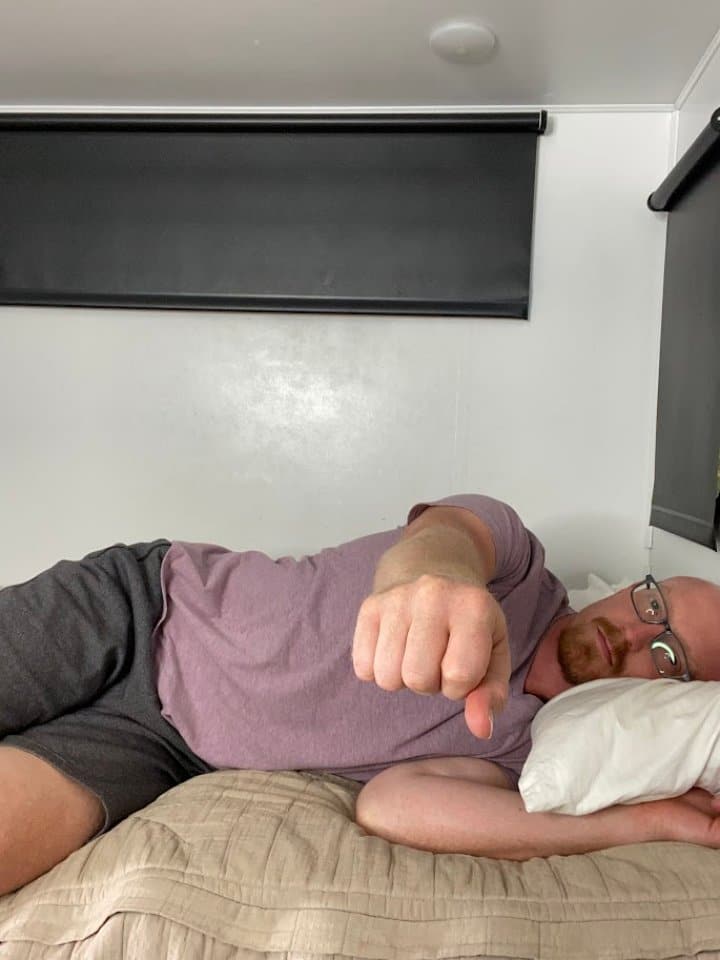
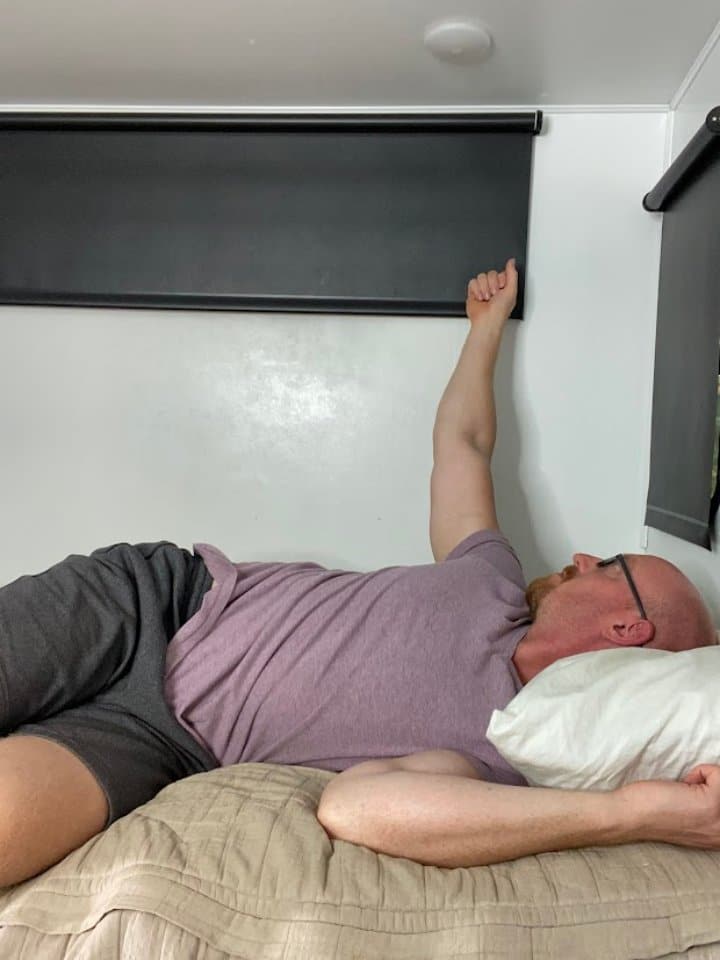
- Begin laying on one side (you can lay on your bed, couch or the floor). Make sure to have pillow support for a neutral neck position. The legs can be relaxed in whatever position is most comfortable.
- Reach the top arm forward, then slowly begin moving it toward the ceiling. Have the head follow this motion.
- Once the arm is pointing towards the ceiling, the rest of the spine should rotate and follow the arm as it continues to move and stretch behind you.
- Only rotate as far as the spine is comfortable with.
- Hold for 5 seconds, then return to your starting position.
- Repeat for 3 repetitions, then perform on the opposite side.
2. Extension Stretch


- Starting position: Using a chair with a back, place your hands behind your head to cradle it and your back positioned against the chair back.
- Slowly lean back, extending your back while looking up towards the ceiling. Make sure not to lean to far back so you don’t tip the chair!
- Hold the stretch for up to 5 seconds, then return to your starting position.
- Perform 10 repetitions.
E: Strengthening Exercises
1. Chin Tucks


- You can perform a chin tuck laying on your back or sitting or standing.
- Gently tuck the chin directly back as if trying to make a double chin. Avoid nodding your head.
- Hold this position for 2 seconds, then slowly relax your muscles.
- Repeat 10 repetitions.
2. Scapular Retraction
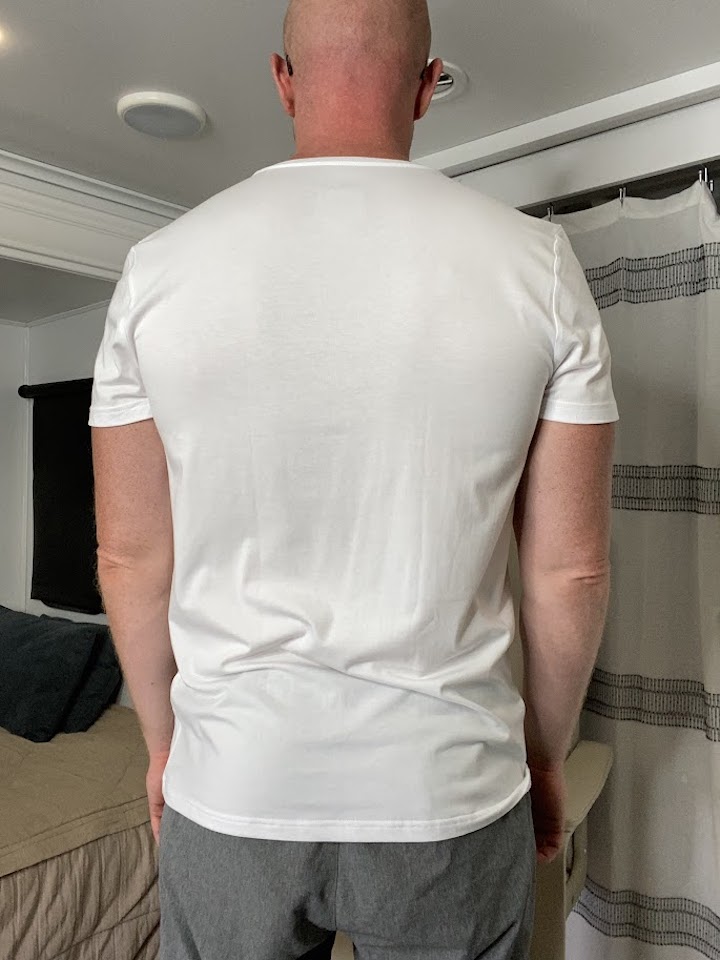

- In a sitting or standing position, try to sit as straight as possible. Aim to position the head in a neutral position as possible.
- Gently pull the shoulders back and squeeze the shoulder blades together.
- Hold for 5 seconds, then relax.
- Repeat 10 repetitions for 3 sets.
3. Rows with Resistance Band
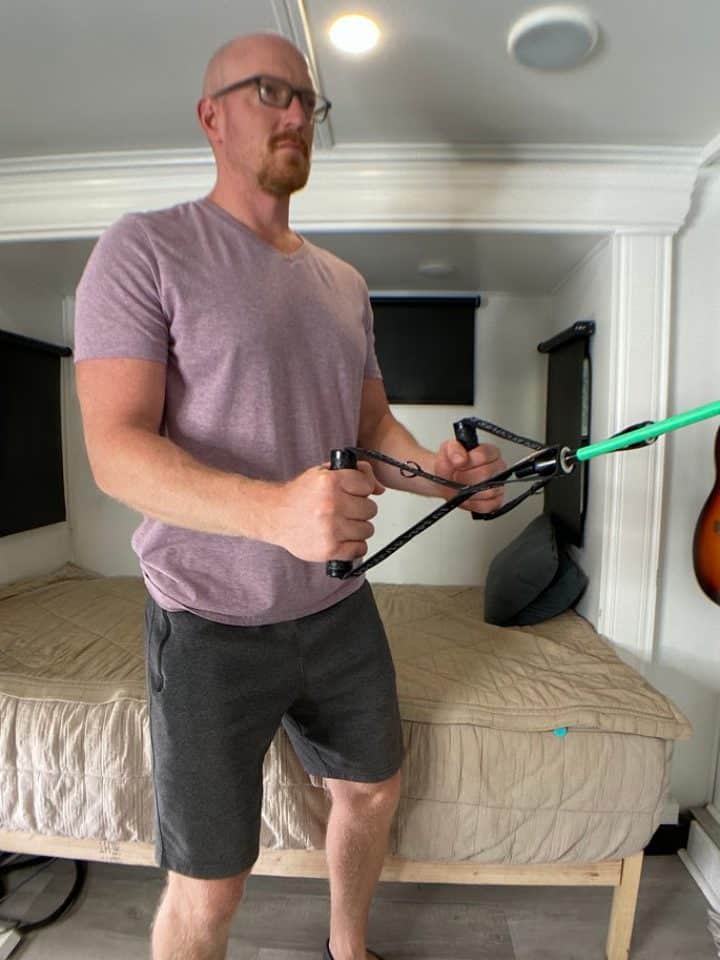
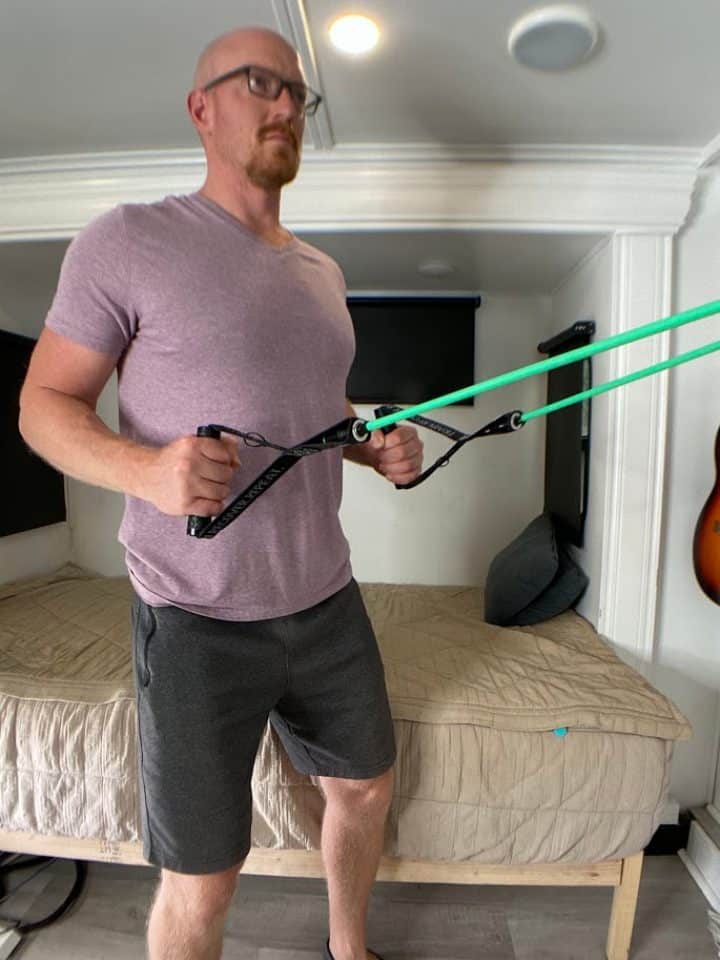
- Hold on to the ends of a resistance band (light, medium or heavy), which you can attach to a door knob.
- Begin with the arms elevated in front of you to shoulder height and the palms facing each other.
- Step back far enough that the resistance bend has a little tension.
- Pull back on the band by bending the elbows and swinging the arms back next to you. Make sure to squeeze the shoulder blades together.
- Hold for 2 seconds, then return to your starting position.
- Repeat 10 repetitions for 3 sets.
4. External Shoulder Rotation with a Resistance Band

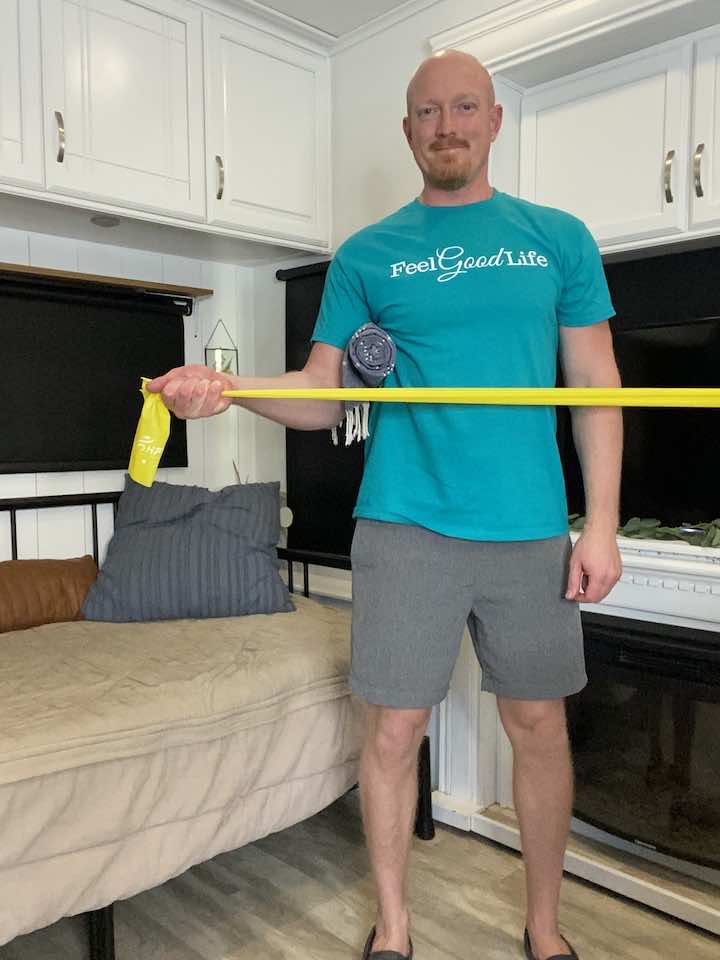
- Attach one end of the resistance band to a secure location, such as a doorknob or post, at the height of your elbow to perform the correct motion.
- Stand facing the band and hold the other end with your hand on the same side, elbow bent at a 90-degree angle and tucked by your side, and palm facing towards your body.
- Keeping an upright posture, slowly pull the band away from your body, rotating your arm outward and away from your torso while maintaining the 90-degree angle of your elbow.
- Hold this position for 2 seconds, then return to your starting position.
- Repeat the movement for 10 repetitions, then switch to the other arm.
- Aim for 3 sets of this exercise.
5. Internal Shoulder Rotation with a Resistance Band

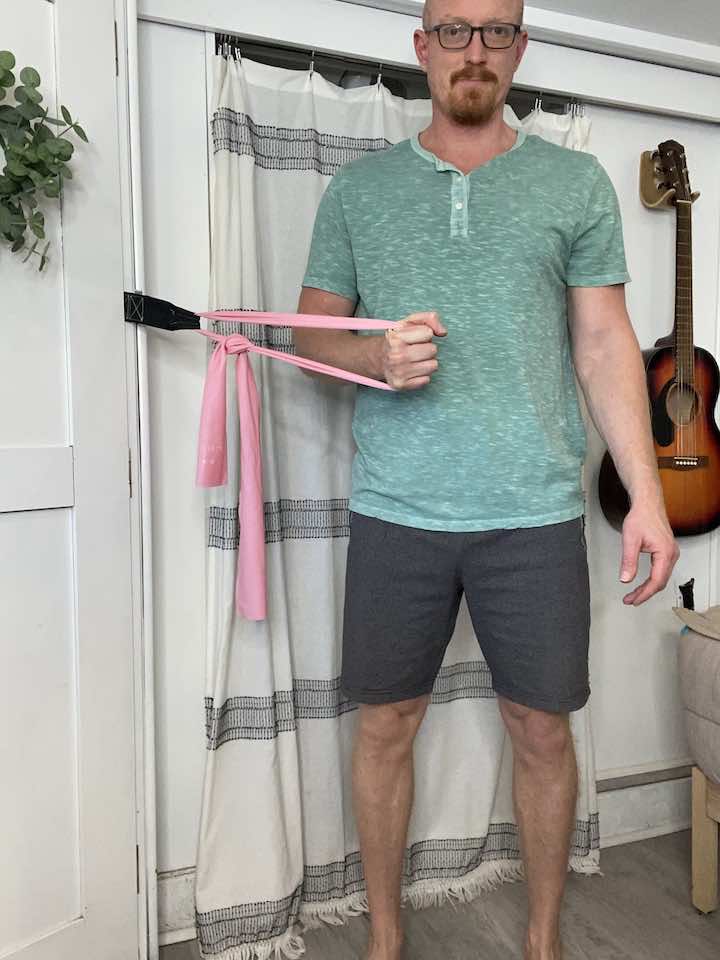
- To perform this exercise, you will need to attach one end of the band to a secure location, such as a doorknob or post, at the height of your elbow to perform the correct motion.
- Keeping an upright posture, slowly pull the band towards your stomach while maintaining the 90-degree angle of your elbow.
- Hold for 2 seconds, then return to your starting position.
- Repeat the movement for 10 repetitions, then switch to the other arm.
- Aim for 3 sets of this exercise.
F: Nerve Glides
1. Ulnar Nerve Glide
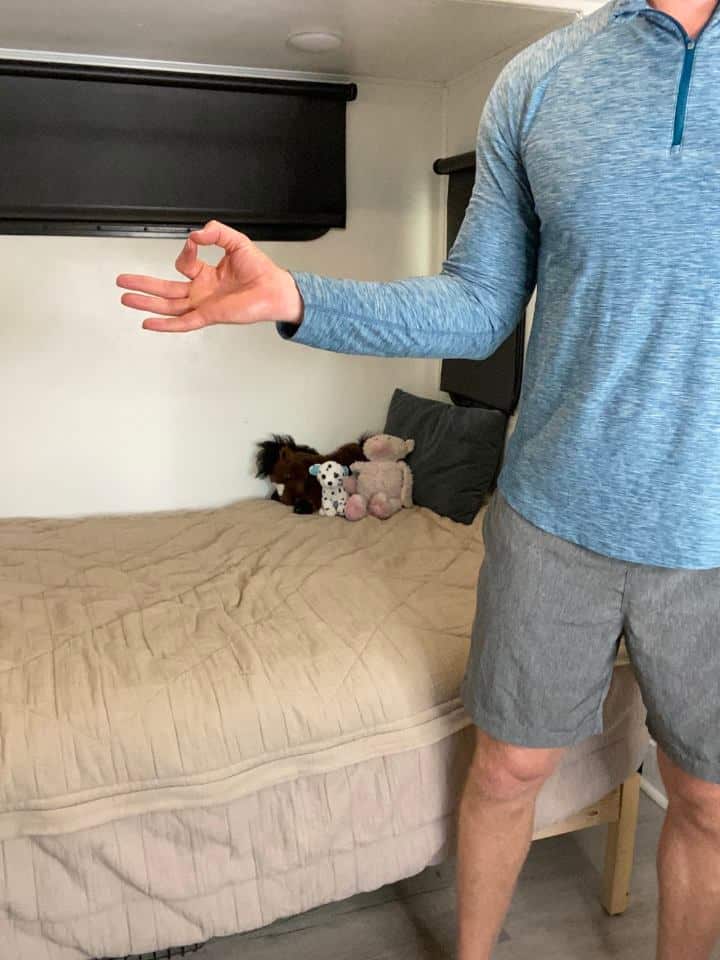
Step 1: Your starting position will be holding your arm out to the side and gently bend the elbow. Make a circle with your thumb and index finger touching as if you’re saying you’re “A-okay.” Your palm should be facing out to the side, away from you.
Step 2: Begin to move the hand towards your head while extending the wrist back towards you. Make sure to keep your “A-okay” sign. The fingers should now be pointing towards you with the palm facing the ceiling.


Step 3: From here, bend the neck so that your head moves away from the working arm.
Step 4: To add an extra stretch to the nerve, slightly lift your bent elbow up towards the ceiling.

2. Median Nerve Glide
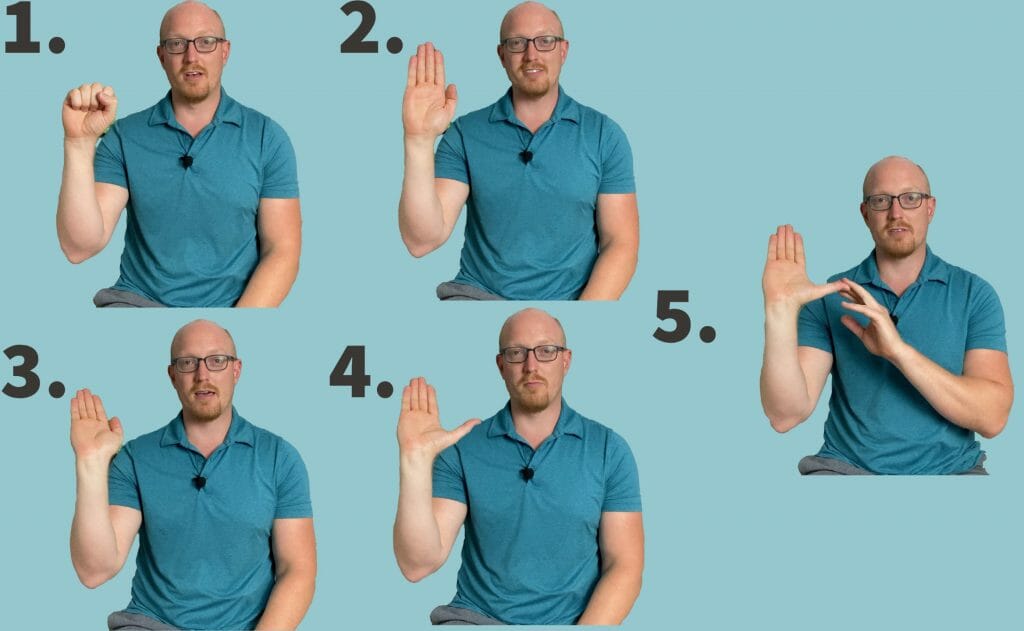
- Stand up straight with your arm by your side and your palm facing up.
- Slowly bend your wrist down to stretch the front of your wrist and palm.
- Bend your head away from your outstretched arm while maintaining good posture and shoulder alignment.
- Hold the position for 2 seconds.
- Return to the starting position with your wrist and head.
- Repeat 10 times.
Care Tips for Spinal Nerve Compression
Taking care of your spine is crucial in managing nerve compression. Here are some tips to keep your spine healthy:
- Maintain a healthy weight to reduce the burden on your spine.
- Engage in regular physical activity to strengthen the muscles supporting your spine.
- Be conscious of your posture, especially when sitting for long periods.
- Ensure your sleeping position supports the natural curve of your spine.
- Stay hydrated to maintain the elasticity and fluidity of the soft tissues surrounding your spine.
- Consider consulting a healthcare professional for personalized advice and treatment options.
Conclusion
Spinal nerve compression can be a daunting condition, but with the right exercises and care, you can manage the pain and improve your quality of life. Remember to be consistent with your exercises, mindful of your posture, and proactive in your approach to spine health.
By integrating these exercises and care tips into your daily routine, you can pave the way for a more comfortable and active life. Always consult with a healthcare professional before starting any new exercise regimen, especially if you’re dealing with a condition like spinal nerve compression. Take the first step towards a pain-free life today!













